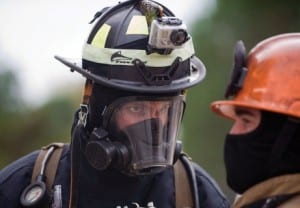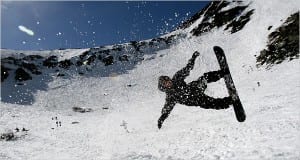 I recently fielded a question from a Situational Awareness Matters member on the use of helmet cameras and the impact it might have on situational awareness. Here is the question:
I recently fielded a question from a Situational Awareness Matters member on the use of helmet cameras and the impact it might have on situational awareness. Here is the question:
Would you please be so kind as to point me in the direction of literature, articles, websites or advice on the impact of personal cameras (especially GoPros) on the situational awareness of rescue team members during a rescue practice (they are banned during “real” rescues). In particular, the impact on helicopter rescue team members.
My hypothesis is that the cameras would diminish situational awareness significantly for both the camera person (who is not concentrating on the task at hand because they are being distracted by “getting the shot”) and those being photographed (by having a camera pointed at them, and trying to look good).
What is your opinion and practice in this matter? Are you aware of any studies, or evidence in this regard?
Surprisingly, this is a question I get asked a lot. To my knowledge there are no empirical studies that address the impact of cameras on situational awareness. However, the principles of situational awareness and the impact of barriers can be observed when cameras are used both in training and at real emergencies. There are two angles I want to address this question from: Behavior modification and task fixation.
Behavior modification
There is plenty of evidence that when a person knows they are being videoed or audio recorded it can impact what they say and how they behave. They can become much more guarded in their actions and much more selective in the words they use if the perception is the evidence caught on the recording might, for some reason, be used against them. Thus, the person may behave and speak in much more conservative ways.
However, the opposite effect could occur as well if someone knows they are being videoed or audio recorded. It is a very real possibility that when a camera is rolling a person may behave in a way that assures their behaviors make for good footage. After all, boring footage isn’t very entertaining and isn’t likely to go viral on social media.
But, footage showing a person taking excessive risks always makes for good footage and will likely get shared a lot. It gives the actors their proverbial fifteen minutes of fame and for some that is enough enticement to act irresponsibly.
I  can share a personal story that demonstrates this effect. About seven years ago I took my son and his friend snow boarding. My son, against my advice, mounted a camera on his helmet to shoot some video. I had advised against this because I thought the presence of the camera would entice him and his friends to take excessive risks for the sake of getting good footage.
can share a personal story that demonstrates this effect. About seven years ago I took my son and his friend snow boarding. My son, against my advice, mounted a camera on his helmet to shoot some video. I had advised against this because I thought the presence of the camera would entice him and his friends to take excessive risks for the sake of getting good footage.
My suspicions were confirmed when one if his friends, first ensuring the camera was rolling, attempted a 360-degree flip off of a jump. Unfortunately, he only made it about 300 degrees and face-planted on the hard-packed snow, blowing out the orbit of his left eye. One of the first questions he asked… did you get it on film? He was more interested In knowing the moment was captured so it could be put on social media than he was about the impending trip to the hospital and the potential loss of vision.
Task Fixation
The second issue has to do with the pre-occupation of operating the camera and getting the right angle and capturing the desired shot. When a person gets focused on the technology, it is easy for them to lose awareness of the presence of danger. The less familiar the operator is with the equipment the easier it is to become fixated on the technology and make sure it’s working properly.
Whether on a training evolution or an actual emergency, the mind needs to be on the event, not in the recording equipment. It’s very easy to get distracted by the recording equipment and, in turn, miss critical clues about what is happening in the periphery.
This happened to me recently while at a sporting event. I was shooting a video on my phone and using the screen on my phone to view the event I was recording. Consequently, I missed something amazing that happened just outside the frame of the camera. I was fixated on the technology and focused shooting good footage.
Rich Gasaway’s Advice
 I am seeing more and more responders using helmet cameras. Some of the cameras are being used with the permission of their departments and some are not. When I ask, the most common explanation is the footage will be used for training purposes. On the surface, I don’t have an issue with capturing video and audio to critique performance.
I am seeing more and more responders using helmet cameras. Some of the cameras are being used with the permission of their departments and some are not. When I ask, the most common explanation is the footage will be used for training purposes. On the surface, I don’t have an issue with capturing video and audio to critique performance.
However, there is a real potential that the presence of the camera will change behavior which many include taking unacceptable risks for the sake of getting good footage.
Departments should have a policy about the use of helmet cameras and address issues about how the use of cameras can impact risk, both in behavior modification and in task fixation.
On a side issue, there may also be concerns about liability depending on what the videos capture and how they are shared. This discussion is outside the scope of the mission of Situational Awareness Matters so I won’t go into depth on that here.
Action Items
 1. Discuss the possibility of how behaviors might change as a result of being filmed or recorded. These behavioral changes might include being more guarded and conservative or more aggressive and risk-averse.
1. Discuss the possibility of how behaviors might change as a result of being filmed or recorded. These behavioral changes might include being more guarded and conservative or more aggressive and risk-averse.
2. Discuss how video being shot with helmet cameras should be used in training.
3. Discuss strategies for avoiding issues related to behavior modification or task fixation while using helmet cameras.
_____________________________________________________

If you are interested in taking your understanding of situational awareness and high-risk decision making to a higher level, check out the Situational Awareness Matters Online Academy.
CLICK HERE for details, enrollment options and pricing.
__________________________________
Share your comments on this article in the “Leave a Reply” box below. If you want to send me incident pictures, videos or have an idea you’d like me to research and write about, contact me. I really enjoy getting feedback and supportive messages from fellow first responders. It gives me the energy to work harder for you.
Thanks,

Email: Support@RichGasaway.com
Phone: 612-548-4424
SAMatters Online Academy
Facebook Fan Page: www.facebook.com/SAMatters
Twitter: @SAMatters
LinkedIn: Rich Gasaway
YouTube: SAMattersTV
iTunes: SAMatters Radio

Interesting questions concerning areas I haven’t thought of. First I’m not a fire fighter. As a 23 year law enforcement officer, body cameras (Taser) have become standard in my profession. At first I was ”aware” the camera was rolling and it did make me second guess what I said and what it was doing. Now it’s second nature to activate the body camera and take care of business. It’s presence does not dictate my actions, it backs me up. Our fire department does use them on scenes. As a fire investigator, the evidence (fire conditions, fire behavior, patterns prior to overhaul, etc) they record is amazing and I use them whenever they’re present. To date I haven’t witnessed risky behavior to get the shot. We have seen footage end up on social media… which is a different concern all together.